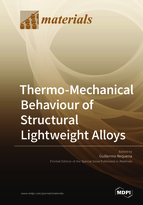Thermo-Mechanical Behaviour of Structural Lightweight Alloys
A special issue of Materials (ISSN 1996-1944).
Deadline for manuscript submissions: closed (31 October 2018) | Viewed by 33242
Special Issue Editor
Interests: light alloys; metals for additive manufacturing; three-dimensional material characterization; synchrotron tomography; high energy synchrotron diffraction; aluminum alloys; titanium alloys; magnesium alloys; titanium aluminides; metal matrix composites; phase transformations; relationships microstructure-properties; thermo-mechanical behavior of metals
Special Issues, Collections and Topics in MDPI journals
Special Issue Information
Dear Colleagues,
The need to reduce the ecological footprint of (water, land, air) vehicles in this era of climate change requires pushing the limits in the development of lightweight structures and materials.
The development and optimization of lightweight metals for structural components requires a thorough understanding of their thermo-mechanical behavior at several stages of the production chain, as well during service conditions. For instance, thermo-mechanical treatments play a decisive role in the processing of wrought products and are beginning to see the light for application in wire-based additive manufacturing technologies. During service, the response of lightweight alloys under the simultaneous influence of mechanical loads and temperature can determine the lifetime and performance of a multitude of structural components used for transportation such as in combustion engines or aircraft turbines.
The present Special Issue is dedicated to disseminate current efforts around the globe aiming at advancing in the understanding of the thermo-mechanical behavior of structural lightweight alloys under processing or service conditions. It is therefore my pleasure to invite you to submit contributions that may take into account this thematic from and experimental or theoretical point of view for Mg, Al, Ti, TiAl alloys, as well innovative composites based on these systems or new lightweight metals.
Prof. Guillermo Requena
Guest Editor
Manuscript Submission Information
Manuscripts should be submitted online at www.mdpi.com by registering and logging in to this website. Once you are registered, click here to go to the submission form. Manuscripts can be submitted until the deadline. All submissions that pass pre-check are peer-reviewed. Accepted papers will be published continuously in the journal (as soon as accepted) and will be listed together on the special issue website. Research articles, review articles as well as short communications are invited. For planned papers, a title and short abstract (about 100 words) can be sent to the Editorial Office for announcement on this website.
Submitted manuscripts should not have been published previously, nor be under consideration for publication elsewhere (except conference proceedings papers). All manuscripts are thoroughly refereed through a single-blind peer-review process. A guide for authors and other relevant information for submission of manuscripts is available on the Instructions for Authors page. Materials is an international peer-reviewed open access semimonthly journal published by MDPI.
Please visit the Instructions for Authors page before submitting a manuscript. The Article Processing Charge (APC) for publication in this open access journal is 2600 CHF (Swiss Francs). Submitted papers should be well formatted and use good English. Authors may use MDPI's English editing service prior to publication or during author revisions.
Keywords
- Aluminum alloys
- magnesium alloys
- titanium alloys
- titanium aluminides
- lightweight metals
- thermo-mechanical behavior







